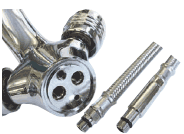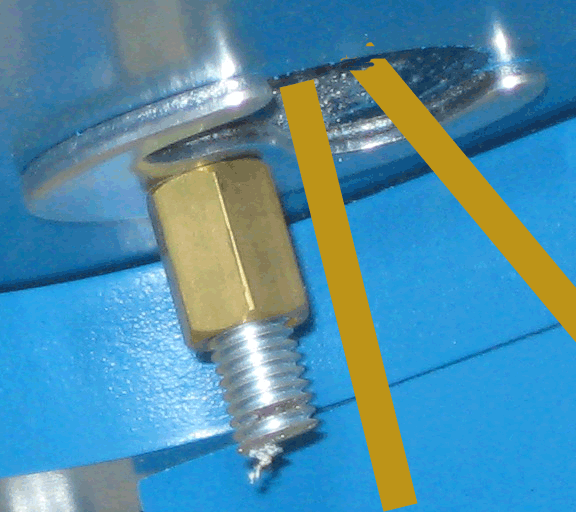It has to be said that fitting a monoblock mixer tap (or monobloc as it’s also spelt) is not the easiest operation in the world and can certainly be a bit fiddly. However, this project should go some way to making it a little easier.
If you do not have any isolation valves handy to cut off the water supply while you carry out your work then you will have to ensure that the water is turned off. Additionally, while the water is off it’s a good idea to fit isolation vales for any work you may need to carry out in the future.
How do Monoblock Taps Work?

Top and bottom of a monoblock tap
The monoblock is a very clever piece of design technology which allows both the hot and cold feed to enter the base, or block of the tap. The temperature is then "mixed" by the operation of the tap valve or handles.
In order for both feeds to get through the same opening they are reduced to 10mm or 8mm and special tap connectors are used to screw into the block.
The image above shows the tap at the top with the connection tails at the bottom ready to receive the hot and cold feeds. The 10mm feed pipes screw into the underside of the tap and are then machined out to become 15mm copper tails ready for the connection of 15mm feeds.
This can be seen more easily in the image below.

Mounting plate for mixer tap seen from underneath a sink
Fixing Your Monoblock Tap to a Sink or Bath
The opening for a monoblock mixer is usually 26mm. This will be, or be close to, the size of the hole in your sink, basin or bath.
Where do the Rubber Washers go?
There should be a large rubber O ring which sits underneath the block and is squashed between the top of the sink and the underside of the block as the monoblock is tightened into place.
A large, flat rubber washer is placed on the underside of the basin and this has holes in it which should line up with the holes in the monoblock.
Where do the Feed Pipes go?
The larger two of these holes are for the feed pipes to be screwed in and the smaller two are where the threaded connection bars are screwed into.

Underside of mono block tap showing feed pipe holes and holes for threaded connection bar
Fit the Threaded Bars First
These threaded bars should be fitted before dropping the tap through the hole in the basin. Only do them up as tight as you can by hand. If you use pliers or grips there is a danger you will damage the thread.

Monoblock tap with double fixing
Sliding on the Steel Washer
Once the tap is in the hole with the flat washer or mounting plate placed over the threaded bars, the steel washer can be slid into place also.
On some models of mixer tap there is only one threaded bar making the job a great deal easier.

Monoblock tap with single nut fixing
Tighten the Nuts on the Threaded Bar
With the washer in place the nuts can now be tightened onto the threaded bar and this is where the DIY enthusiast struggles.
Use a Box Spanner
There is hardly any room under the basin, less under a bath and a kitchen sink is a nightmare! Plumbers on the other hand, carry a box spanner which is a long open tube with the correct size nut shaped hole at the end.
It is slid over the thread and the other end twisted tight by putting a nail or something similar into the hole and turning. Easy!

Box spanner
Connecting any Pipework
Once the tap is securly fixed into place you can now go ahead and connect up any pipework.
Speedfit fittings can be used on monoblock feed pipes so click into the speedfit project to see more or you can use standard fittings but make sure they are the correct size of course.
Ensure that any compression fittings are tightened up sufficiently and you can then turn back on the water or open any isolation valves.
Once pressurised, check your work for any leaks.

